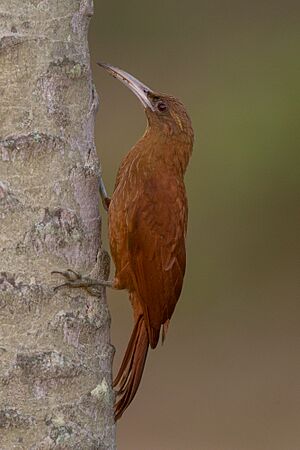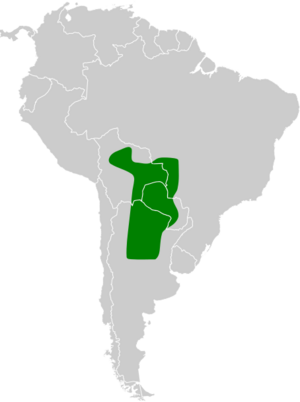Great rufous woodcreeper facts for kids
Quick facts for kids Great rufous woodcreeper |
|
|---|---|
 |
|
| at Bonito, Mato Grosso do Sul State, Brazil | |
| Conservation status | |
| Scientific classification | |
| Genus: |
Xiphocolaptes
|
| Species: |
major
|
 |
|
The great rufous woodcreeper (Xiphocolaptes major) is a cool bird that lives in parts of South America. It's known for its bright reddish-brown feathers. This bird is part of the ovenbird family called Furnariidae. You can find it in countries like Argentina, Bolivia, Brazil, and Paraguay.
Contents
What is the Great Rufous Woodcreeper?
Scientists group living things into categories. This helps us understand how they are related. The great rufous woodcreeper is a type of bird. It belongs to a group called Dendrocolaptinae. This group is part of the larger ovenbird family called Furnariidae.
Scientists have found four slightly different types, or subspecies, of the great rufous woodcreeper:
- X. m. remoratus
- X. m. castaneus
- X. m. estebani
- X. m. major (This is the main type, called the nominate subspecies.)
What Does the Great Rufous Woodcreeper Look Like?
The great rufous woodcreeper is the biggest bird in its group, but not the heaviest. It has a strong body and a long, curved beak. These birds are about 27 to 34 centimeters (11 to 13 inches) long.
Male birds usually weigh between 120 and 150 grams (4.2 to 5.3 ounces). Females are a bit heavier, weighing 120 to 162 grams (4.2 to 5.7 ounces). Both male and female birds look very similar.
Colors and Markings
Most great rufous woodcreepers are a bright reddish-brown color, like cinnamon.
- Their head is a little darker.
- Their tail is more of a chestnut color.
- Their wing feathers are reddish-brown with dark tips.
- The area around their eyes (called lores) is blackish.
- Their throat is a pale cinnamon with whitish streaks.
- Their belly has some dark brownish bars.
- Their eyes can be dark brown, red-brown, or crimson.
- Their beak is light-colored, from horn to white.
- Their legs and feet are dark grayish-green or bluish-gray.
Younger birds are usually brighter in color than adults. They have stronger streaks on their chest but weaker ones on their head.
Subspecies Differences
Each subspecies has slight differences in color:
- X. m. remoratus is darker on its upper parts than the main type. Its underparts are less reddish and have more streaks and bars.
- X. m. castaneus is darker overall. It has a browner head and deeper chestnut upper parts. It has fewer streaks and bars on its underparts.
- X. m. estebani is much lighter in color than the main type, but otherwise looks similar.
Where Does the Great Rufous Woodcreeper Live?
These birds live in different parts of South America, depending on their subspecies:
- X. m. remoratus lives in the southwestern Mato Grosso state of Brazil.
- X. m. castaneus is found in north-central and eastern Bolivia, southern Brazil's Mato Grosso do Sul state, and northwestern Argentina's Jujuy and Salta provinces.
- X. m. estebani lives in northwestern Argentina's Tucumán Province.
- X. m. major is found in western Paraguay and northern Argentina, as far south as Córdoba and Santa Fe provinces.
Habitat
The great rufous woodcreeper lives in many types of forests. These include dry woodlands, semi-deciduous woodlands (where some trees lose leaves), and gallery forests (forests along rivers). They also live in Gran Chaco woodlands. You might also find them in scrubby forests, cerrado (a type of savanna), and wooded savannas.
They prefer to stay deep inside the forest but sometimes go to the edges. They mostly live below 1,500 meters (4,900 feet) in elevation, but can be found as high as 1,800 meters (5,900 feet).
How Does the Great Rufous Woodcreeper Behave?
Movement
The great rufous woodcreeper stays in the same area all year round. It does not migrate to different places.
Feeding Habits
This bird mainly eats insects. It also eats smaller amounts of other arthropods (like spiders) and small animals with backbones. It usually looks for food alone or in pairs. Sometimes, you might see three birds together, which are likely a family group.
They do not follow swarms of army ants, which some other birds do to catch prey. They also don't usually join groups of different bird species that feed together. They search for food from the ground up to the middle layers of the forest. They turn over leaves on the ground and climb along tree trunks and branches. They poke and pick at things to find their prey.
Reproduction and Life Cycle
We don't know all the details about when great rufous woodcreepers breed. However, we know they breed in October and November. They build their nests inside a hole in a tree. This hole might be natural or made by a woodpecker. They add materials like leaves and wood chips to make the nest cozy.
A female bird usually lays two or three eggs. We don't know how long the eggs take to hatch or when the young birds leave the nest. We also don't know much about how the parents care for their babies.
Vocalization
The great rufous woodcreeper's song is a series of 5 to 8 double-noted whistles. It sounds like "wéettuck - -". The song is loud and has a ringing sound. They also make a two-part call that sounds like an "eeehr-eek!".
What is the Great Rufous Woodcreeper's Status?
The IUCN (International Union for Conservation of Nature) has looked at the great rufous woodcreeper. They have listed it as a species of "Least Concern." This means it's not currently in danger of disappearing.
Even though it has a large area where it lives, we don't know exactly how many of these birds there are. Scientists believe their numbers might be going down. No immediate big threats have been found for this bird. It is generally considered rare to uncommon, but it is more common in some places.
Scientists think this bird is not very sensitive to losing its habitat or other human activities. Because of this, it's not a top priority for conservation efforts right now.


